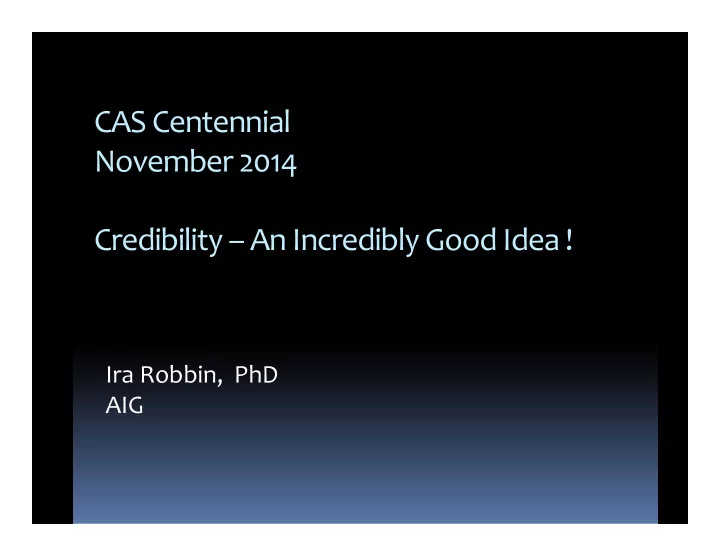

CAS Centennial November 2014 Credibility – An Incredibly Good Idea ! Ira Robbin, PhD AIG
CAS Antitrust Notice 2 The Casualty Actuarial Society is committed to adhering strictly to the letter and spirit of the antitrust laws. Seminars conducted under the auspices of the CAS are designed solely to provide a forum for the expression of various points of view on topics described in the programs or agendas for such meetings. Under no circumstances shall CAS seminars be used as a means for competing companies or firms to reach any understanding – expressed or implied – that restricts competition or in any way impairs the ability of members to exercise independent business judgment regarding matters affecting competition. It is the responsibility of all seminar participants to be aware of antitrust regulations, to prevent any written or verbal discussions that appear to violate these laws, and to adhere in every respect to the CAS antitrust compliance policy . 2
Balancing Experience vs Initial Estimate 3 I nitial Estim ate Experience Revised Estimate 3
Credibility Estimate Linear mix of actual and expected * ( 1 ) µ = + − • E = initial (prior) mean= complement • A = mean of actual data • z = credibility ( ) * µ − 1 = = + 4
Credibility: Our Big Idea 5 Original meaning (1914): reliability of data for ratemaking How much data is needed for it to be fully credible What happens if data is not 100% credible? Give it partial credibility Credibility is the weight to be given to data-based estimate versus the complement of credibility The complement is 0% change, the overall avg, …. Claimed as a unique contribution from American P&C actuaries Contrasted with pure frequentist approaches taken by statisticians at the time 5
We Can’t Stop Writing About It 6 Mowbray 1914 “How Extensive a Payroll Exposure is Necessary to Give a Dependable Pure Premium ” Whitney 1918 “The Theory of Experience Rating” Perryman 1932 – “Notes on Credibility” Dorweiler 1934 “…Risk Credibility in Experience Rating” Bailey 1945 – “A Generalized Theory of Credibility” Bailey and Simon 1959 – “Credibility of … Private Passenger Car” Hurley 1954 – “ ..Credibility Framework for …Fire Classification…” Longley- Cook 1962 - “An Introduction to Credibility Theory” Mayerson 1964 - “A Bayesian View of Credibility” Buhlman 1967- “Experience Rating and Credibility” Hewitt 1966- “Credibility- An American Idea” Philbrick – “Examination of Credibility Concepts” Dean 1996– “Introduction to Credibility” Venter 2003 – “Credibility Theory for Dummies” 6
Property Casualty Insurance Applications 7
Credibility Impact on Rates Limited Individual Risk Full z Class Fluctuation Experience Standards Credibility over time Rating defines when improves tempers a reduces accuracy by excessive state/territory/ instability in capturing year-to-year class group is class rate differences rate large enough differentials not reflected movement for self rating by class plan
Conceptual Virtues of Credibility Balances Stability Systematically Provides realistic versus reflects our and fair Responsiveness beliefs incentives Gives classes and Prevents excessive How much risk states reasonable volatility in rates classes differ credits/penalties Attempts to Heterogeneity of Motivates efficient recognize signal individuals within a level of safety and and not mimic the class loss control noise of actual data.
Classic Credibility Full z standard 10 Number of Claims needed to achieve z=100% Longley-Cook derivation Uses Normal Distrib approximation ( ) > Pr [ ] [ ] − < E[N]= Expected Number of Claims Required P = Level of confidence k = width of interval 99% 95% 90% 2.5% 10,623 6,147 4,326 5.0% 2,656 1,537 1,082 7.5% 1,180 683 481 10.0% 664 384 271 10
Two Classic Options for Partial Z 11 n z C = ⋅ n k + n = Expected number of claims k selected to hit desired “swing” C chosen so z= 100% at full z standard n z = N 100 % Square root rule 11
Classic Z Criticisms and Limitations 12 Lack of coherent theoretical foundation Importance of prior knowledge stressed but not used in derivation of full z standard Insurance losses are skewed and do not follow the Normal distribution Need to reflect Severity, not just Frequency Insufficient awareness of Off-balance and possible bias. No valid conceptual rationale for use of loss capping and loss splitting procedures Over the years, actuaries addressed all these issues 12
Modifying Our Beliefs- Bayes 13 ( ) θ ( | ) ( | ) θ = θ ( ) X is RV parametrically dependent on θ Define h( θ) as the prior distribution of the parameter Define h( θ |x) as the posterior distribution of the parameter 13
The Mysterious Prior 14 Captures the unknown Records what we think we know How confident are we? Inherent uncertainty Our knowledge is not exact Sampling error How much the future could vary from the past Variation beyond expected sampling error 14
Modifying the Expectation- Bayes 15 = [ | ] [ ( )] ( | ) θ ⋅ θ θ Parametric Model X ( θ) is RV parametrically dependent on θ A = Actual result of an experiment 15
Bayesian Credibility 16 [ ] 2 ( ) 2 ( ) ( 1 ) ( | ) ( ) ε = µ θ − + − µ ⋅ θ ⋅ θ θ 0 Best linear fit Optimal Z gives best fit to the parametric model Mean Square Error fit minimizes ε 2 Z never reaches 100% in theory 16
Recommend
More recommend